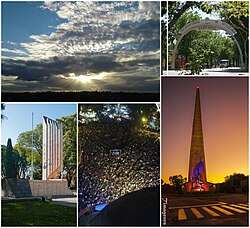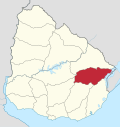Treinta y Tres
Treinta y Tres | |
|---|---|
Capital city | |
 | |
| Coordinates: 33°14′0″S 54°23′0″W / 33.23333°S 54.38333°W | |
| Country | |
| Department | |
| Founded | 10 March 1853 |
| Government | |
| • Mayor | Mario Silvera Araujo |
| Elevation | 63 m (207 ft) |
| Population (2011 Census) | |
| • Total | 25,477 |
| • Demonym | Treintaitresino |
| Time zone | UTC -3 |
| Postal code | 33000 |
| Dial plan | +598 445 (+5 digits) |
| Climate | Cfa |
Treinta y Tres (Spanish pronunciation: [ˈtɾejntaj ˈtɾes]) is the capital city of the Treinta y Tres Department in eastern Uruguay. It is known for its role in the development of folk music.
History
[edit]Its name means "Thirty Three" and refers to the 19th-century national heroes, the 33 Orientales, who established the independence of Uruguay in 1825. Coincidentally, the city is located near the 33°S line of latitude, making the name doubly appropriate.
On 10 March 1853 it was declared a "Pueblo" (village) by the Act of Ley Nº 307 and on 20 September 1884 it was made capital of the department created by Ley Nº 1.754. According to the Act of Ley Nº 3.544, on 19 July 1909 it held the status of "Villa" (town), which was elevated to "Ciudad" (city) on 29 September 1915 by the Act of Ley 5.335.[1]
Six years later, in 1859, the first school for children was inaugurated. Three years later, in 1862, the first school for girls began to operate.
The first trip that connects Treinta y Tres with Montevideo was made in 1861 by a stagecoach service, but only in 1866 did this service become permanent, also linking the city with Río Branco, Melo, and Nico Pérez. It was linked by railroad in 1912.
Population
[edit]In 2011, Treinta y Tres had a population of 25,477.[2] It is by far the largest town in what is a sparsely populated department. Together with Ejido de Treinta y Tres and the southwestern suburb of Villa Sara, they form a population centre of around 33,000 inhabitants.
|
| |||||||||||||||||||||||||||
| Source: Instituto Nacional de Estadística de Uruguay[1] | ||||||||||||||||||||||||||||
Economy
[edit]The economy of Treinta y Tres is based on livestock and derived products. Currently, rice is the main crop grown, flourishing among the city's many rivers. This activity has given a great boost to the region's economy, promoting the pre-cooked products industry and the installation of rice mills. In recent years, there has also been a significant boom in the cement and limestone industry.
Geography
[edit]
The city is located on Route 8, on the north banks of Olimar Grande River. The city is almost surrounded by a populated rural area, a zone of chacras (ranches), known as Ejido de Treinta y Tres.
Climate
[edit]The climate in this area is characterized by hot, humid summers and generally mild to cool winters. According to the Köppen Climate Classification system, Treinta y Tres has a humid subtropical climate, abbreviated "Cfa" on climate maps.[3]
| Climate data for Treinta y Tres (1991–2020, extremes 1939–2020) | |||||||||||||
|---|---|---|---|---|---|---|---|---|---|---|---|---|---|
| Month | Jan | Feb | Mar | Apr | May | Jun | Jul | Aug | Sep | Oct | Nov | Dec | Year |
| Record high °C (°F) | 41.1 (106.0) |
40.5 (104.9) |
40.2 (104.4) |
36.4 (97.5) |
31.2 (88.2) |
29.0 (84.2) |
31.2 (88.2) |
34.7 (94.5) |
35.0 (95.0) |
34.8 (94.6) |
39.7 (103.5) |
41.5 (106.7) |
41.5 (106.7) |
| Mean daily maximum °C (°F) | 30.0 (86.0) |
29.0 (84.2) |
27.5 (81.5) |
23.9 (75.0) |
20.1 (68.2) |
17.1 (62.8) |
16.5 (61.7) |
18.4 (65.1) |
19.8 (67.6) |
22.8 (73.0) |
25.8 (78.4) |
28.5 (83.3) |
23.3 (73.9) |
| Daily mean °C (°F) | 23.9 (75.0) |
23.3 (73.9) |
21.7 (71.1) |
18.4 (65.1) |
14.9 (58.8) |
12.2 (54.0) |
11.6 (52.9) |
13.2 (55.8) |
14.6 (58.3) |
17.5 (63.5) |
19.9 (67.8) |
22.2 (72.0) |
17.8 (64.0) |
| Mean daily minimum °C (°F) | 17.8 (64.0) |
17.6 (63.7) |
16.0 (60.8) |
13.0 (55.4) |
9.8 (49.6) |
7.4 (45.3) |
6.7 (44.1) |
8.0 (46.4) |
9.4 (48.9) |
12.1 (53.8) |
14.0 (57.2) |
16.1 (61.0) |
12.3 (54.1) |
| Record low °C (°F) | 1.8 (35.2) |
4.5 (40.1) |
2.0 (35.6) |
−1.2 (29.8) |
−2.8 (27.0) |
−7.6 (18.3) |
−4.6 (23.7) |
−4.0 (24.8) |
−4.2 (24.4) |
−1.2 (29.8) |
1.4 (34.5) |
1.0 (33.8) |
−7.6 (18.3) |
| Average precipitation mm (inches) | 110.1 (4.33) |
121.2 (4.77) |
107.7 (4.24) |
137.8 (5.43) |
136.6 (5.38) |
125.5 (4.94) |
107.7 (4.24) |
118.7 (4.67) |
118.8 (4.68) |
120.8 (4.76) |
82.5 (3.25) |
122.6 (4.83) |
1,410 (55.52) |
| Average precipitation days (≥ 1.0 mm) | 7 | 7 | 7 | 7 | 7 | 8 | 7 | 7 | 7 | 8 | 6 | 8 | 86 |
| Average relative humidity (%) | 70 | 74 | 76 | 79 | 81 | 83 | 81 | 79 | 77 | 75 | 72 | 70 | 76 |
| Mean monthly sunshine hours | 266.6 | 214.7 | 220.1 | 183.0 | 170.5 | 132.0 | 145.7 | 164.3 | 174.0 | 210.8 | 240.0 | 263.5 | 2,385.2 |
| Mean daily sunshine hours | 8.6 | 7.6 | 7.1 | 6.1 | 5.5 | 4.4 | 4.7 | 5.3 | 5.8 | 6.8 | 8.0 | 8.5 | 6.5 |
| Source 1: Instituto Uruguayo de Metereología[4][5] | |||||||||||||
| Source 2: NOAA (precipitation and sun 1991–2020),[6] Instituto Nacional de Investigación Agropecuaria (humidity and sun 1980–2009)[7] | |||||||||||||
Places of worship
[edit]- St. Joseph the Worker Parish Church (Roman Catholic)
- Parish Church of Our Lady of the Thirty-Three (Roman Catholic)
- Parish Church of the Holy Savior (Roman Catholic)
Notable people
[edit]- Emiliano Alfaro - footballer
- Gonzalo Lemes - footballer
- Darío Silva - footballer
- Octavio Rivero - footballer
References
[edit]- ^ a b "Statistics of urban localities (1908–2004)" (PDF). INE. 2012. Retrieved 6 September 2012.
- ^ "Censos 2011 Cuadros Trenta y Tres". INE. 2012. Archived from the original on 10 October 2012. Retrieved 25 August 2012.
- ^ Climate Summary for Treinta y Tres, Uruguay
- ^ "Estadísticas climatológicas : Estacion Meteorologica Treinta y tres" (in Spanish). Dirección Nacional de Meteorología. Retrieved 16 May 2023.
- ^ "RECORDS METEOROLOGICOS EN EL URUGUAY" (in Spanish). Dirección Nacional de Meteorología. Retrieved 16 May 2023.
- ^ "Treinta y Tres Climate Normals 1991–2020". World Meteorological Organization Climatological Standard Normals (1991–2020). National Oceanic and Atmospheric Administration. Archived from the original on 7 August 2023. Retrieved 7 August 2023.
- ^ Castaño, José; Giménez, Agustín; Ceroni, Mauricio; Furest, José; Aunchayna, Rossina. "Caracterización Agroclimática del Uruguay 1980–2009" (PDF) (in Spanish). Instituto Nacional de Investigación Agropecuaria. Archived from the original (PDF) on 12 December 2018. Retrieved 15 December 2018.



